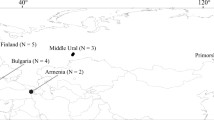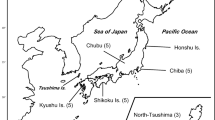Abstract.
Previous studies of cattle MHC have suggested the presence of at least four classical class I loci. Analysis of haplotypes showed that any combination of one, two or three genes may be expressed, although no gene is expressed consistently. The aim of this study was to examine the evolutionary relationships among these genes and to study their phylogenetic history in Cetartiodactyl species, including cattle and their close relatives. A secondary aim was to determine whether recombination had occurred between any of the genes. MHC class I data sets were generated from published sequences or by polymerase chain reaction from cDNA. Phylogenetic analysis revealed that MHC class I sequences from Cetartiodactyl species closely related to cattle were distributed among the main cattle gene "groups", while those from more distantly related species were either scattered (sheep, deer) or clustered in a species-specific manner (sitatunga, giraffe). A comparison between gene and species trees showed a poor match, indicating that divergence of the MHC sequences had occurred independently from that of the hosts from which they were obtained. We also found two clear instances of interlocus recombination among the cattle MHC sequences. Finally, positive natural selection was documented at positions throughout the alpha 1 and 2 domains, primarily on those amino acids directly involved in peptide binding, although two positions in the alpha 3 domain, a region generally conserved in other species, were also shown to be undergoing adaptive evolution.



Similar content being viewed by others
References
Adams EJ, Thomson G, Parham P (1999) Evidence for an HLA-C-like locus in the orangutan Pongo pygmaeus. Immunogenetics 49:865–871
Bensaid A, Kaushal A, Baldwin CL, Clevers H, Young JR, Kemp Sj, MacHugh ND, Toye PG, Teale AJ (1991) Identification of expressed bovine class I MHC genes at 2 loci and demonstration of physical linkage. Immunogenetics 33:247–254
Boyson JE, Shufflebotham C, Cadavid LF, Urvater JA, Knapp LA, Hughes AL, Watkins DI (1996) The MHC class I genes of the rhesus monkey. J Immunol 156:4656–4665
Cadavid LF, Mejia B, Watkins DI (1999) MHC class I genes in a New World primate, the cotton-top tamarin, have evolved by an active process of loci turnover. Immunogenetics 49:196–205
Di Palma F, Archibald SD, Young JR, Ellis SA (2002) A BAC contig of approximately 400 kb contains the classical class I MHC genes of cattle. Eur J Immunogenet 29:65–68
Ellis SA, Martin AJ, Holmes EC, Morrison WI (1995) At least 4 MHC class I genes are transcribed in the horse. Eur J Immunogenet 22:249–260
Ellis SA, Staines KA Morrison WI (1996) cDNA sequence of cattle MHC class I genes transcribed in serologically defined haplotypes A18 and A31. Immunogenetics 43:156–159
Ellis SA, Holmes EC, Staines KA, Smith KB, Stear MJ, McKeever DJ, MacHugh ND, Morrison WI (1999) Variation in the number of expressed MHC genes in different cattle class I haplotypes. Immunogenetics 50:319–328
Figueroa F, Mayer WE, Sato A, Zaleska-Rutczynska Z, Hess B, Tichy H, Klein J (2001) Mhc class I genes of swordtail fishes, Xiphophorus: Variation in the number of loci and existence of ancient gene families. Immunogenetics 53:695–708
Fremont DH, Matsumura M, Stura EA, Peterson PA, Wilson IA (1992) Crystal structures of 2 viral peptides in complex with murine MHC class I H-2Kb. Science 257:919–926
Gaddum RM, Cook RS, Furze JM, Ellis SA, Taylor G (2003) Recognition of bovine respiratory syncytial virus proteins by bovine CD8+ T lymphocytes. Immunology 108:220–229
Garrigan D, Hedrick PW (2001) Class I MHC polymorphism and evolution in endangered California Chinook and other Pacific salmon. Immunogenetics 53:483–489
Geller R, Adams EJ, Guethlein LA, Little A-M, Madrigal JA, Parham P (2002) Linkage of Patr-AL to Patr-A and -B in the MHC of the common chimpanzee. Immunogenetics 54:212–215
Hassanin A, Douzery EJP (1999) The tribal radiation of the family Bovidae (Artiodactyla) and the evolution of the mitochondrial cytochrome b gene. Mol Phylogenet Evol 13:227–243
Hegde NR, Ellis SA, Gaddum RM, Tregaskes CA, Sarath G, Srikumaran S (1995) Peptide motif of the cattle MHC class I antigen BoLA-A11. Immunogenetics 42:302–303
Holmes EC, Ellis SA (1999) Evolutionary history of MHC class I genes in the mammalian order Perissodactyla. J Mol Evol 49:316–324
Holmes EC, Worobey M, Rambaut A (1999) Phylogenetic evidence for recombination in dengue virus. Mol Biol Evol 16:405–409
Joly E, Leong L, Coadwell J, Clarkson C, Butcher GW (1996) The rat MHC haplotype RT1 c expresses 2 classical class I molecules. J Immunol 157:1551–1558
Klein J, Ono H, Klein D, O'hUigan C (1993) The accordion model of MHC evolution. In: Gergely J (ed) Progress in Immunology VIII. Springer, Heidelberg Berlin New York, pp 137–146
Kumar S, Hedges SB (1998) A molecular timescale for vertebrate evolution. Nature 392:917–920
Matthee CA, Robinson TJ (1999) Cytochrome b phylogeny of the family Bovidae: resolution within the Alcelaphini, Antilopini, Neotragini, and Tragelaphini. Mol Phylogenet Evol 12:31–46
Miyamoto MW, Kraus F, Laipis PJ, Tanhauser SM, Webb SD (1993) Mitochondrial DNA phylogenies within artiodactyla. In: Szalay FS, Novacek MJ, McKenna MC (eds) Mammalian phylogeny (vol. 2 Placentals). Springer, New York Berlin Heidelberg, pp 268–281
Paquet ME, Williams DB (2002) Mutant MHC molecules define interactions between components of the peptide-loading complex. Int Immunol 14:347–358
Parham P, Adams EJ, Arnett K (1995) The origins of HLA-A, B, C polymorphism. Immunol Rev 143:140–180
Pichowski JS, Ellis SA, Morrison WI (1996) Sequence of 2 cattle MHC class I cDNAs associated with BoLA specificity. Immunogenetics 43:253–254
Rambaut A, Grassly NC (1997) Seq-Gen: an application for the Monte Carlo simulation of DNA sequence evolution along phylogenetic trees. CABIOS 13:235–238
Renard C, Vaiman M, Chiannilkulchai N, Cattolico L, Robert C, Chardon P (2001) Sequence of the pig MHC region containing the classical class I genes. Immunogenetics 53:490–500
Salter RD, Norment AM, Chen BP, Clayberger C, Krensky AM, Littman DR, Parham P (1989) Polymorphism in the alpha 3 domain of HLA-A molecules affects binding to CD8. Nature 338:345–347
Sanger F, Nicklen S, Coulson AR (1977) DNA sequencing with chain-terminating inhibitors. Proc Natl Acad Sci U S A 74:5463–5469
Shilling HG, Guethlein LA, Cheng NW, Gardiner CM, Rodriguez R, Tyan D, Parham P (2002) Allelic polymorphism synergizes with variable gene content to individualize human KIR genotype. J Immunol 168:2307–2315
Swofford DL (2002) PAUP*. Phylogenetic Analysis Using Parsimony (*and other methods). Version 4. Sinauer, Sunderland, Mass., USA
Taracha ELN, Goddeeris BM, Teale AJ, Kemp SJ, Morrison WI (1995) Parasite strain specificity of bovine CTL responses to Theileria parva is determined primarily by immunodominance. J Immunol 155:4854–4860
Trowsdale J (2001) Genetic and functional relationships between MHC and NK receptor genes. Immunity 15:363–374
Wagner JL, Sarmiento UM, Storb R (2002) Cellular, serological, and molecular polymorphism of the class I and class II loci of the canine MHC. Tissue Antigens 59:205–210
Wroblewski JM, Kaminsky SG, Nakamura I (1994) Bat-1 genes and the origin of multiple class I loci in the H-2D region. Immunogenetics 39:276–280
Yang Z (1997) PAML: a program package for phylogenetic analysis by maximum likelihood. CABIOS 13:555–556
Yang Z, Nielsen R, Goldman N, Pedersen AMK (2000) Codon-substitution models for heterogeneous selection pressure at amino acid sites. Genetics 155:431–449
Acknowledgements.
This work was supported by the Biological Sciences and Biotechnology Research Council, UK, and the Wellcome Trust. We would like to thank Edmund Flach at Whipsnade Wild Animal Park, and Dr. Niall MacHugh, Moredun Research Institute, for providing blood samples, and Mike Charleston for assisting with the TreeMap analysis. Experiments carried out in this study comply with UK law.
Author information
Authors and Affiliations
Corresponding author
Rights and permissions
About this article
Cite this article
Holmes, E.C., Roberts, A.F.C., Staines, K.A. et al. Evolution of major histocompatibility complex class I genes in Cetartiodactyls. Immunogenetics 55, 193–202 (2003). https://doi.org/10.1007/s00251-003-0560-2
Received:
Revised:
Published:
Issue Date:
DOI: https://doi.org/10.1007/s00251-003-0560-2




